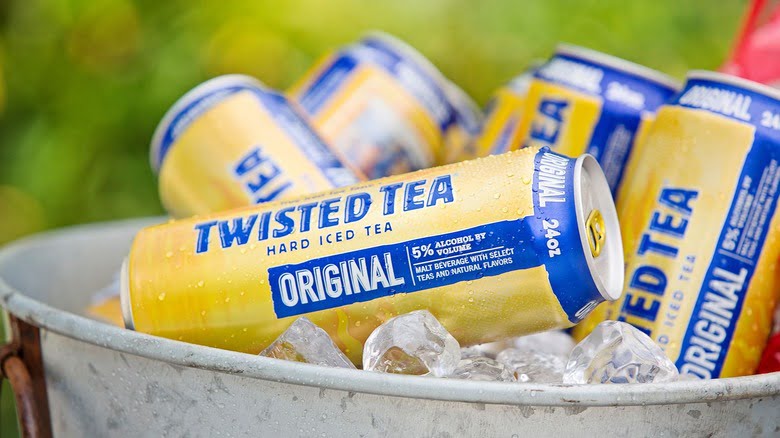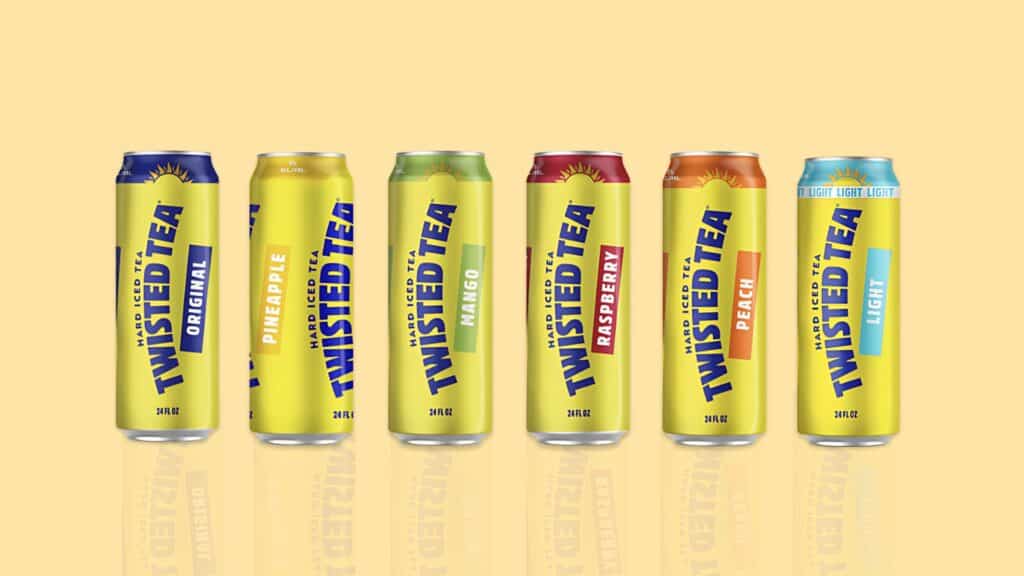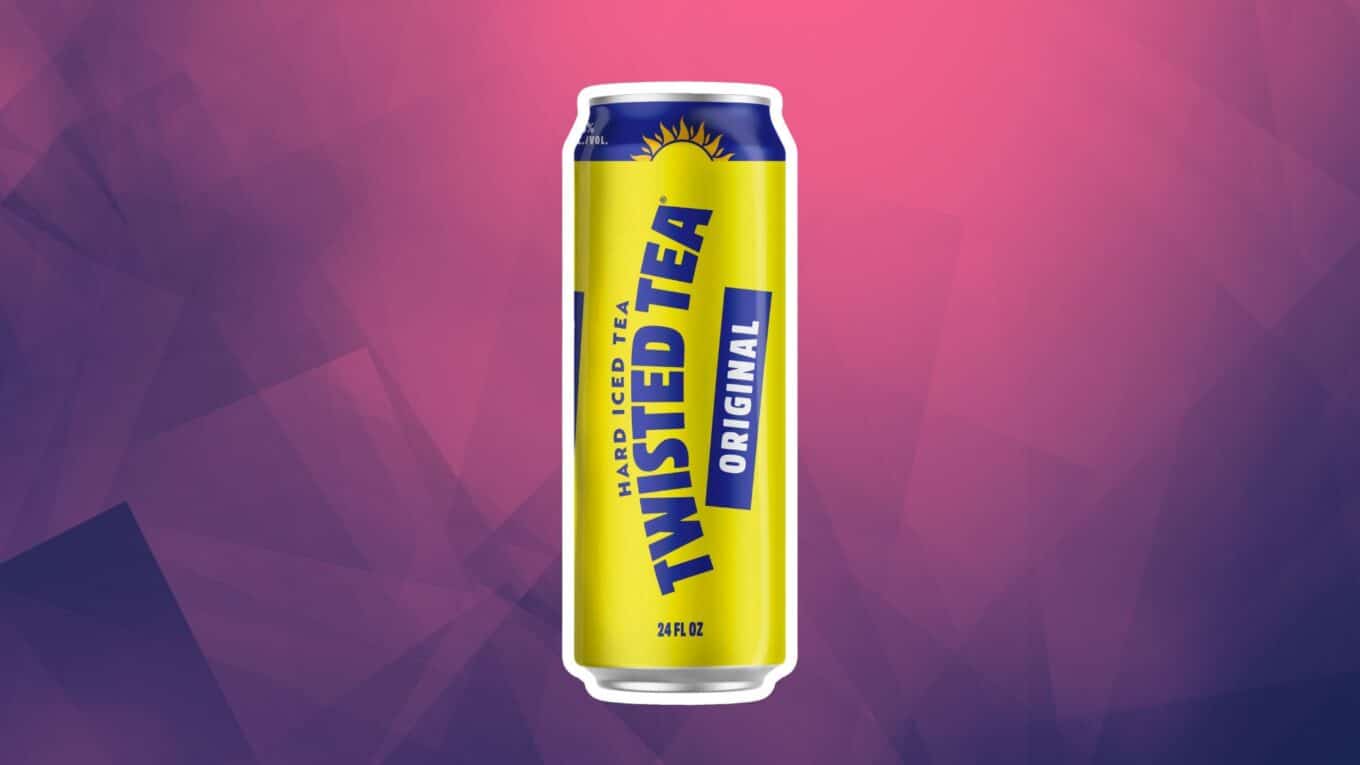Twisted Tea has become popular for those looking for a refreshing, flavorful alternative to traditional beer.
However, many consumers may not fully understand the unique fermentation process behind this beloved beverage.
In this article, we will thoroughly explore the fascinating world of Twisted Tea.
We will cover its history, key ingredients, and brewing techniques contributing to its unique flavor.
We will discuss the malt base, the role of real brewed tea, and the natural flavors that make Twisted Tea distinctive.
Additionally, we will examine the different flavor variants, the marketing strategies employed, and the nutritional aspects of the beverage.
By the end, you will understand what goes into each can and how it stands out in the market compared to other popular drinks.
History of Twisted Tea

Twisted Tea, a refreshing blend of real brewed tea and malt liquor, has captured the hearts of countless consumers since its introduction in 2001.
With its unique flavor profile and growing market presence, Twisted Tea has become a staple in flavored malt beverages.
Origin
- The story of Twisted Tea began when the Cincinnati-based company Twisted Tea Brewing Company set out to create a beverage that combined the beloved taste of tea with the kick of alcohol.
- Recognizing the increasing demand for ready-to-drink alcoholic beverages, Twisted Tea aimed to fill a gap in the market by offering a high-quality, tea-infused alternative to beer and other malt drinks.
Over the years, Twisted Tea has undergone significant changes to keep up with evolving consumer preferences and market trends.
From tweaks in the brewing process to updates in packaging design, the brand has continuously adapted to stay relevant and appealing to its target audience.
These efforts have paid off, as Twisted Tea has experienced steady growth and expanded its distribution network across the United States.
Twisted Tea: Different Flavors and Variants

Twisted Tea’s original flavor combines smooth tea with a hint of lemon, providing a balanced and refreshing taste.
Using real brewed tea leaves and a malt base creates a unique flavor profile that has become synonymous with the brand.
Twisted Tea has introduced various variants to cater to different tastes and seasonal demands.
These new flavors attract a wider audience and keep existing customers engaged.
- Half & Half: A blend of classic Twisted Tea and refreshing lemonade.
- Peach: A sweet and fruity twist on the original, featuring natural peach flavors.
- Raspberry: A tart and juicy variant combining real brewed tea with a ripe raspberry taste.
- Mango: A tropical escape that infuses mango flavors into the classic Twisted Tea base.
Limited edition flavors like Blackberry and Passion Fruit create buzz and drive seasonal sales.
These unique offerings help Twisted Tea maintain its position as a leader in the flavored malt beverage category, with strong sales and a dedicated consumer base.
Alcohol Content and Ingredients in Twisted Tea
| Aspect | Twisted Tea | Mike’s Hard Lemonade | Smirnoff Ice | Four Loko |
|---|---|---|---|---|
| Ingredients | Black tea leaves, Malt base, Natural and artificial flavorings, Cane sugar, Citric acid | Malt base, Lemon juice concentrate, Natural flavors, High fructose corn syrup, Citric acid | Carbonated water, Malt base, High fructose corn syrup, Natural flavors, Citric acid | Malt base, Artificial flavors, High fructose corn syrup, Caffeine, Guarana |
| Brewing Techniques | Steeping of black tea leaves, Fermentation of malt base, Flavor blending | Fermentation of malt base, Flavor infusion, Carbonation | Fermentation of malt base, Carbonation, Flavor blending | Fermentation of malt base, High alcohol content achieved through specific fermentation techniques, Flavor, and caffeine infusion |
| Flavor Profiles | Sweet, Tea-like, Refreshing with a hint of lemon (Half & Half variant), and Fruity in other variants. | Sweet, Tart, Lemon-forward | Sweet, Tart, Citrus-forward | Sweet, Intense, Fruity, High alcohol content |
Twisted Tea, a popular flavored malt beverage, has an alcohol content comparable to many standard beers.
The classic Twisted Tea flavors typically have an Alcohol by Volume (ABV) of around 5%, achieved through the fermentation of the malt base.
However, it’s worth noting that some special editions or limited-release flavors of Twisted Tea may have slightly higher or lower alcohol content.
For example, the Twisted Tea Light varieties have a lower ABV of 4%, while the Twisted Tea Harder lineup boasts an elevated ABV of 8%.
Unlike other flavored malt beverages, Twisted Tea stands out for its unique blend of real brewed tea and a malt base.
- While some competitors may rely heavily on artificial flavors or sweeteners, Twisted Tea prides itself on using authentic tea leaves to create its signature taste.
- In contrast to hard seltzers, which have gained popularity in recent years, Twisted Tea offers a more robust and full-bodied flavor profile.
- The malt base gives Twisted Tea a distinct character that differentiates it from the lighter, more neutral taste of hard seltzers.
- Traditional iced teas that contain alcohol, such as spiked iced teas, often use distilled spirits like vodka or rum as their alcohol base.
- Twisted Tea, conversely, derives its alcohol content from the fermentation of the malt base, resulting in a smoother and more cohesive flavor profile.
Twisted Tea: Key Ingredients and Their Roles

1. Malt Base
The malt base serves as the foundation of Twisted Tea, providing the primary source of alcohol and contributing to the beverage’s body and mouthfeel.
The fermentation of the malt base is what gives Twisted Tea its characteristic smooth and slightly sweet taste.
The choice of malted grains used in the malt base also influences Twisted Tea’s overall flavor profile.
The quality and type of malts can impart subtle notes of caramel, bread, or nuttiness, adding depth and complexity to the drink.
2. Tea Water
One key element distinguishing Twisted Tea from other malt beverages is using real brewed tea water.
The tea water is created by steeping high-quality tea leaves, typically black tea, in hot water to extract the tea’s flavor, color, and aroma.
The tea water is then integrated into the malt base during brewing, infusing the beverage with the classic tea taste that is Twisted Tea’s hallmark.
Authentic tea water sets Twisted Tea apart from other flavored malt beverages that may rely on artificial tea flavors.
3. High Fructose Corn Syrup
High fructose corn syrup (HFCS) is used as a sweetener in Twisted Tea to balance the tea’s bitterness and the base’s maltiness.
HFCS is a cost-effective and stable sweetener that helps to create a consistent flavor profile across batches.
The use of HFCS contributes to the overall sweetness of Twisted Tea, making it an appealing choice for consumers who prefer a sweeter taste in their alcoholic beverages.
However, it’s important to note that the sweetness level can vary across different flavors and varieties of Twisted Tea.
4. Additional Flavorings
Twisted Tea offers a range of flavors beyond the original tea taste, including popular variants such as lemon, peach, and raspberry.
These flavorings are added to the base Twisted Tea formula to create unique and refreshing taste profiles.
Including natural and artificial flavors allows Twisted Tea to appeal to consumer preferences and offers variety in the malt beverage market.
These flavorings are carefully selected to complement the tea and malt base, resulting in well-balanced and enjoyable flavor combinations.
Twisted Tea’s successful strategy of using additional flavorings has helped the brand expand its customer base and maintain its position as a leader in the flavored malt beverage category.
Regularly introducing new and limited-edition flavors keeps consumers engaged and excited about the brand.
The Fermentation Process of Twisted Tea
1. Concept of Fermentation
Fermentation is a metabolic process where yeast converts sugars into alcohol and carbon dioxide.
This process is essential in brewing alcoholic beverages, including beer, wine, and malt drinks like Twisted Tea.
In brewing, fermentation produces alcohol and contributes to the unique flavors and aromas in the final product.
The choice of ingredients, yeast strain, and fermentation conditions all play a crucial role in determining the beverage’s characteristics.
2. Specific Fermentation Process Used in Twisted Tea
Twisted Tea’s fermentation process differs from traditional beer brewing.
Unlike beer, which relies heavily on hops for flavor and bitterness, Twisted Tea uses a blend of real brewed tea and malt base to create its signature taste.
The fermentation process is carefully controlled to ensure a balanced flavor profile and a refreshing drinking experience.
Combining the malt base, tea leaves, and selected yeast strain produces the desired alcohol content and taste.
3. Malt Base Preparation
The malt base forms the foundation of Twisted Tea’s fermentation process.
High-quality grains, primarily malted barley, are selected for their ability to provide fermentable sugars and contribute to the overall flavor.
The malt base preparation involves several steps:
- Including malting, mashing, and lautering.
- Malting involves steeping the grains in water, allowing them to germinate, and drying them.
- This step helps develop enzymes that convert starches in the grains into fermentable sugars during mashing.
- Mashing mixes the malted grains with hot water to activate the enzymes and extract the sugars.
- The resulting liquid, called wort, is separated from the spent grains during lautering,
Leaving a clear, sweet liquid ready for fermentation.
4. Use of Black Tea Leaves
High-quality black tea leaves are crucial in creating Twisted Tea’s distinct flavor.
The tea leaves are carefully selected for their robust flavor and ability to complement the malt base.
The black tea leaves are steeped in hot water during brewing to extract their flavor, aroma, and color.
The steeping time and temperature are controlled to ensure a consistent and well-balanced tea infusion that harmonizes with the other ingredients.
5. Integration of Sugars and Flavorings
In addition to the sugars derived from the malt base, Twisted Tea may include other sugars, such as high fructose corn syrup, to provide additional fermentable sugars and enhance the beverage’s sweetness.
Natural and artificial flavorings are added to create various Twisted Tea variants, like lemon, peach, or raspberry.
These flavorings complement the tea’s natural taste and aroma, resulting in various refreshing and enjoyable flavors.
6. Role of Yeast and Alcohol Production
The yeast strain used in Twisted Tea’s fermentation is specifically selected for its ability to thrive in the tea-infused malt base.
- The chosen yeast strain is known for its consistent performance in producing the desired alcohol content and flavor profile.
- During fermentation, the yeast consumes the sugars in the tea-infused malt base, converting them into alcohol and carbon dioxide.
- The fermentation process is carefully monitored to ensure optimal yeast performance and the desired alcohol by volume (ABV) for Twisted Tea, typically around 5%.
- The interaction between the yeast, malt base, tea leaves, and other ingredients during fermentation determines the final taste, aroma, and mouthfeel of Twisted Tea.
The careful selection and management of these components result in a well-balanced, refreshing, and flavorful malt beverage popular among consumers.
Nutritional Aspects of Twisted Tea

As consumers become increasingly health-conscious, understanding the nutritional content of beverages like Twisted Tea is more important than ever.
Many people are now carefully considering their drinks’ calories, sugar, and other components, whether for weight management, general health, or personal dietary goals.
By examining the nutritional aspects of Twisted Tea, consumers can make more informed decisions about how this beverage fits into their overall dietary plan.
This information can help them balance their intake, moderate consumption, and maintain a healthy lifestyle while still enjoying the unique flavor and experience of Twisted Tea.
1. Caloric Content and Serving Sizes
On average, a 12-ounce serving of Twisted Tea contains around 190-220 calories, depending on the specific flavor and formulation.
This caloric content is similar to many other flavored malt beverages and some beers but higher than most light beers or hard seltzers.
Consuming larger quantities or multiple servings can quickly increase the total caloric intake.
Additionally, some of Twisted Tea’s specialty or limited-edition flavors may have slightly higher or lower calorie counts due to ingredients and sugar content variations.
For those monitoring their calorie intake, being mindful of serving sizes and choosing lower-calorie options within the Twisted Tea range can help manage overall consumption.
For example, Twisted Tea Light can provide a similar flavor experience with a reduced caloric impact.
2. Sugar Content and Health Considerations
One 12-ounce serving of Twisted Tea typically contains around 23-30 grams of sugar, depending on the flavor.
This sugar content is primarily derived from added sugars that balance the tea’s bitterness and provide a refreshing taste.
However, consuming excessive amounts of added sugars can have negative health implications.
- Regular intake of high-sugar beverages has been linked to an increased risk of obesity, type 2 diabetes, and other metabolic disorders.
- The American Heart Association recommends that adult women consume no more than 25 grams of added sugar daily, while men should limit their intake to 36 grams daily.
- Considering these guidelines, it’s clear that consuming multiple servings of Twisted Tea can quickly exceed the recommended daily sugar intake.
They may also opt for lower-sugar alternatives or limit their consumption to special occasions.
By being aware of the sugar content and making informed choices, consumers can still enjoy Twisted Tea while minimizing potential health risks.
3. Caffeine Content Comparison with Coffee
Twisted Tea contains some caffeine and is brewed with real tea leaves.
However, the caffeine content is relatively low compared to other popular caffeinated beverages like coffee.
- A 12-ounce serving of Twisted Tea contains approximately 30 milligrams of caffeine, while a typical 8-ounce cup contains around 95 milligrams.
- For those sensitive to caffeine or considering limiting their intake, Twisted Tea can be more suitable than coffee or energy drinks.
- The beverage’s lower caffeine content allows consumers to enjoy it without experiencing higher-caffeine alternatives’ more intense stimulating effects.
However, it’s still important to consider individual caffeine sensitivity and overall consumption.
Some people may be more affected by even small amounts of caffeine, particularly if consumed later in the day.
As a general rule, avoiding caffeinated beverages, including Twisted Tea, is recommended in the hours before bedtime to prevent sleep disruption.
By being mindful of their tolerance and consumption habits, consumers can make informed decisions about how Twisted Tea fits into their lifestyle and dietary preferences.
Conclusion
In conclusion, Twisted Tea has carved out a unique niche in the alcoholic beverage market thanks to its distinctive flavor profile and carefully crafted brewing process.
By combining the refreshing taste of real brewed tea with the kick of a malt beverage, Twisted Tea offers consumers a one-of-a-kind experience that sets it apart from traditional beers and iced teas.
While it’s important to be aware of Twisted Tea’s gluten content and nutritional aspects, this beverage can still be enjoyed in moderation as part of a balanced lifestyle.
Whether you’re a fan of the original flavor or excited to try the latest seasonal offerings, Twisted Tea provides a refreshing and flavorful choice for those seeking something different in their drinking repertoire.
So, grab a cold Twisted Tea, kick back, and tell us your taste in twisted tea.
Frequently Asked Questions
Are There Any Gluten-Free Alternatives to Twisted Tea?
Yes, there are gluten-free alternatives to Twisted Tea, such as hard ciders, seltzers, and some gluten-free beers. Always check labels to ensure the beverage is gluten-free.
How Can I Find out More About the Gluten Content in Twisted Tea?
Check the product label or contact the manufacturer directly for specific information on the gluten content in Twisted Tea, as it may vary between flavors and batches.
What Should I Do if I Accidentally Consume Twisted Tea and Have a Gluten Sensitivity?
If you have gluten sensitivity and accidentally consume Twisted Tea, monitor your symptoms and contact your healthcare provider if you experience severe or persistent reactions.
Is Twisted Tea Safe for Individuals with Gluten Sensitivities or Celiac Disease?
Twisted Tea is unsafe for those with gluten sensitivities or celiac disease, as it contains gluten from the malted barley used in the brewing process.
Does Twisted Tea Contain Gluten?
Twisted Tea contains gluten because its malt base is derived from gluten-containing grains like barley. People with gluten sensitivities should avoid drinking it.




